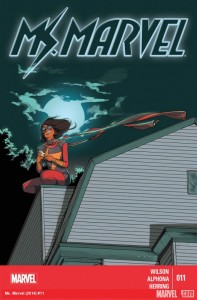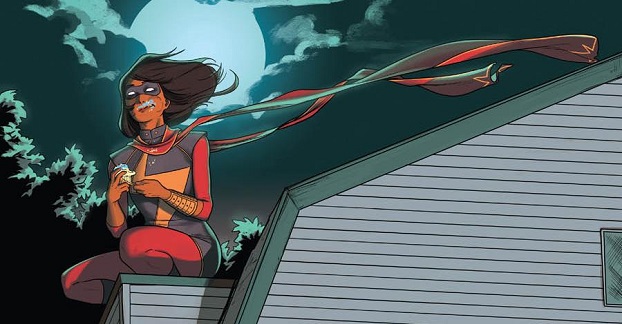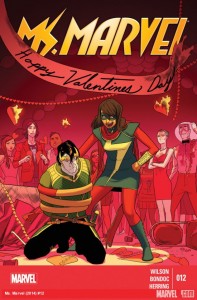Note: This post contains spoilers for those who haven’t read the 11th and 12th issues of Ms. Marvel. Purchase them on Amazon [#11, #12] and Comixology [#11, #12] or at your local comic book store.
 The final 2014 issue of Ms. Marvel exposed the mysterious, bird-like Inventor as a “wannabe evil genius who thinks he’s saved the future when really he’s just given up on it,” as Kamala Khan puts it to him in the opening panels of Ms. Marvel #11. While his plan was unconventional — powering his experiments with “human batteries,” and in so doing curbing overpopulation and reducing the carbon footprint — it apparently convinced a generation of Jersey City teenagers so disillusioned and guilty about their impact on the earth that they willingly volunteered themselves for his cause.
The final 2014 issue of Ms. Marvel exposed the mysterious, bird-like Inventor as a “wannabe evil genius who thinks he’s saved the future when really he’s just given up on it,” as Kamala Khan puts it to him in the opening panels of Ms. Marvel #11. While his plan was unconventional — powering his experiments with “human batteries,” and in so doing curbing overpopulation and reducing the carbon footprint — it apparently convinced a generation of Jersey City teenagers so disillusioned and guilty about their impact on the earth that they willingly volunteered themselves for his cause.
After a destructive, robot-heavy hunt for Ms. Marvel at Coles Academic High School, and with his grand scheme finally revealed, the Inventor finally seemed like a credible nemesis after his initially weak reception in an otherwise thoroughly intelligent and enjoyable new comic series. Yet, all the same, something about the bird-like bad guy as a villain remained unconvincing, with moments of tension always underscored by humor, and conflicts often conveniently resolved by the end of the issue — perhaps until now.
In Issue #11, the Inventor reminds Kamala that it’s “only a matter of time” before he uncovers, from video footage, her true identity “under that fig leaf of a domino mask”: a nod, perhaps, to the pervasiveness of surveillance these days. To add to Kamala’s worries, he has acquired her best friend Nakia for his electricity grid, and now the stakes are raised; the entirely involuntary “last minute acquisitions” to his project sure did not consent to be there.
And next — he wants her. “It’s time for you to join your friends,” the Inventor declares. Indeed, in a swift yet expected plot twist, the other kids join Kamala in trying to overpower the Inventor and his robots. The overwhelming situation leads Kamala to reflect on her limitations to “be in three places at once”: Vick and the others, Nakia, and even Lockjaw all need her, but even she knows already that “nobody can be all things to all people.”
Fortunately, like “all the heroes [she’s] ever loved [who] work in teams,” Ms. Marvel too has allies she can count on: Bruno, Lockjaw, and even the Jersey City police. Despite an overall improved state of affairs by the end, compared to the start, of this issue, this showdown is a sobering moment of maturity for Kamala. She realizes that “her new normal is no normal,” not just because situations too big for her to handle alone can have unexpected and unpleasant outcomes, but also that because of her secret identity, she can’t go to the hospital with her best friend, lest Nakia recognize who she truly is. “This isn’t just a costume anymore,” Kamala accepts, but a “parallel life.”

Kris Anka’s cover for this issue shows Kamala enjoying a cupcake, frosting all over her mouth, her hair and dupatta blowing in the wind on a moonlit night: a light-hearted and well-deserved moment of solace. Even as the events of this issue suggest that such moments of peaceful, anonymous solitude may be fewer and farther between for Kamala Khan, there is also an acknowledgement that, perched on this suburban rooftop, her perspective is already different from when she was seated on a lamppost, looking out across the Hudson to New York (Issue #5): home to Spider-Man, Captain Marvel, the Avengers, and the lot.
For now, through her own conscious choice, her field of vision, and action, has narrowed from the possibilities of the big City to the well-known yet newly unfamiliar terrains of her hometown: the Circle Q grocery store, even her own high school. “Not many of the boots-and-capes crew spend time tracking lost kids in Jersey City, if you know what I mean,” a local police officer tells her as they survey the aftermath of the face-off with the Inventor. But then again, as she’s recently learned, Kamala isn’t exactly like her heroes either — she’s not a mutant, but Inhuman.
As she has before, in such moments of personal struggle as at the end of Ms. Marvel #11, Kamala not only reassures herself but also steps up to serve as a source of support for others, by drawing strength from the two things that perhaps matter to her most: her home (Jersey City, and its youth) and her family (in this case, her Abu’s advice). This issue, like the others before it, is not without moments of physical humor — Kamala’s frizzy hair, the Inventor’s megalomaniacal ramblings, and the rebelling teenagers’ moments of bravado. But throughout, Kamala’s inner monologue, rich, keenly observed and somehow never frantic, resonates, revealing more about this thoughtful and sensitive young heroine, and that this series is strongest when it commits to emotional depth.
 Ms. Marvel #12 is further proof of this series’ ability to balance goofy comedy with genuine feeling and intelligent social commentary. Issue #12 features Loki Laufeyson, “God of Mischief, Agent of the All-Mother” — a strategic move that is sure to delight his numerous fans — but still remains very accessible to readers less familiar with the character (he’s Thor’s little brother). Everything you need to know to understand what Loki’s like is swiftly yet subtly referenced within this issue, which, in many ways, proves to be a viable introductory issue for someone new to the Ms. Marvel series, in addition to offering a refreshing break from the overarching plot, after the mellow ending to Issue #11.
Ms. Marvel #12 is further proof of this series’ ability to balance goofy comedy with genuine feeling and intelligent social commentary. Issue #12 features Loki Laufeyson, “God of Mischief, Agent of the All-Mother” — a strategic move that is sure to delight his numerous fans — but still remains very accessible to readers less familiar with the character (he’s Thor’s little brother). Everything you need to know to understand what Loki’s like is swiftly yet subtly referenced within this issue, which, in many ways, proves to be a viable introductory issue for someone new to the Ms. Marvel series, in addition to offering a refreshing break from the overarching plot, after the mellow ending to Issue #11.
The plot’s pretty simple: Loki is being temporarily “reassigned” by his Asgardian parents to “a corner of Midgard that has too long been neglected by the gods…New Jersey.” He’s to find a way into Coles Academic High School and “neutralize” any remaining threats in the aftermath of the Inventor’s shenanigans. Really, though, Ms. Marvel #12 is, right from its tacky cover all washed in red, a gleeful excuse to celebrate the twin honored institutions of Valentine’s Day, and a staple feature of American entertainment: the school dance.
In the care of any decently capable writer this would be an enjoyable set-up, but because Ms. Marvel has G. Willow Wilson, it is admirably self-aware in its embracing of “patriarchal capitalist display of fake affection” (Nakia keeps it so real). This is perhaps most apparent in Bruno’s deconstruction of the mythical “friend-zone” concept but there are also other clever moments, like the running joke that Loki, with his “Hipster Viking” outfit, must be a Williamsburg trust fund kid, and smaller details like non-heterosexual couples seen at the school dance (and they’re included without any special attention drawn to them).
THANK YOU @GWillowWilson for teenage boys decrying the virulent myth of the friendzone :’) :’) #MsMarvel pic.twitter.com/0jmfYYwLFn
— aditi shiva (@aditishiva) March 3, 2015
Ms. Marvel #12 reveals, through scenes of gentle yet very natural conversational intimacy, more about both lead and minor characters who form part of Kamala’s extended social circles. At the Circle Q grocery store, Bruno struggles to express his feelings for Kamala, while his brother Vick and Loki try to help him out. Their boyish banter is in fact a consideration — an actual articulation — of teenage conceptions of masculinity, of “how to get the girl.”
On the night of the dance, Nakia and Kamala are relaxing in the latter’s bedroom, reading magazines. In this private space where it’s just the two of them girls, Nakia has uncovered and let down her hair. Mulling over the anonymous love letter from a “secret admirer” (Loki’s doing, of course) left on her pillow, Kamala turns thoughtful for a moment, seriously considering “being in love,” while Nakia remains the skeptical voice of reason. As is common in this series, the light-hearted mood is quickly restored with Nakia joking about a “nice young doctor from a respectable Karachi family,” and headstrong Kamala insisting they have to find out who sent her the letter. But for a moment there, we get a real glimpse at two young women, talking about love, in a moment free from superpowers and secret identities that further complicate everything.
At the Valentine’s Day Dance, we again see Wilson present young people as multifaceted individuals. Under the influence of punch spiked with “Asgardian truth elixir,” the “love-stricken teenagers” start to get real honest with each other. Under its influence, popular couple Josh and Zoe are revealed to be, respectively, not just the “dumb jock” and airheaded blonde, but a math-lover with a high PSAT score and a perfectly articulate girl who resents being spoken to in “monosyllables” (it gives her, “like, this surge of ennui” about their relationship).
#ОмниМомент #Marvel Ms. Marvel vol.3 #12 pic.twitter.com/6VkQUD9H23
— OmniMir (@OmniMir) February 25, 2015
Like every good story of this sort, there’s of course a confrontation between Kamala and Loki, and it ends with the latter, under the influence of his own truth elixir, offering the students some meaningful advice. Still costumed as Ms. Marvel, Kamala acknowledges Bruno’s unwavering support — “Valentine’s Day is supposed to be about romance and stuff, but other kinds of love are just as important, right?” — and they fist-bump it out. Ms. Marvel #12: Loki in Love is a fun interlude in the series’ overarching plot, which will hopefully continue to explore the emotional interiority of its various characters.
* * *
Ms. Marvel is written by G. Willow Wilson and edited by Sana Amanat. Issue #11 features art by Adrian Alphona, and #12 art by Elmo Bondoc. Both issues are colored by Ian Herring and lettered by Joe Caramagna, with cover art by Kris Anka. Join the “Kamala Korps” and find out about upcoming issues on the series’ official tumblr. Issue #13 releases on March 11.
Aditi Shiva is a graduate student, freelance writer and sometime editor of comics and young adult fiction, in Singapore. She tweets at @aditishiva.












